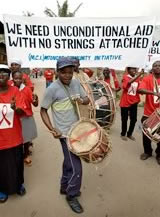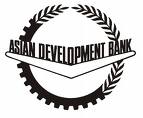The major international lending banks and development agencies have all promoted a policy prescription for developing countries that includes privatisation of state-owned enterprises and liberalisation of access for foreign investment in those enterprises. This policy prescription has benefited banks, multinational corporations and international financial institutions, often at the expense of local business, and always at the expense of the poor.
 World Bank and the International Monetary Fund (IMF) used their growing influence over debt-laden developing nations to force them to open their public services to foreign investment. They employed free market economic theories to argue that private enterprises are more efficient and that the money earned from sales could be used to pay off some of their debts. Privatisation is routinely prescribed for countries seeking loans. These institutions “have overseen wholesale privatizations in economies that were previously state-sector dominated” as well as “privatization of services that are regularly maintained in the public sector in rich countries”.
World Bank and the International Monetary Fund (IMF) used their growing influence over debt-laden developing nations to force them to open their public services to foreign investment. They employed free market economic theories to argue that private enterprises are more efficient and that the money earned from sales could be used to pay off some of their debts. Privatisation is routinely prescribed for countries seeking loans. These institutions “have overseen wholesale privatizations in economies that were previously state-sector dominated” as well as “privatization of services that are regularly maintained in the public sector in rich countries”.
Privatisation is routinely prescribed for countries seeking loans from these institutions. The IMF and the World Bank “have overseen wholesale privatizations in economies that were previously state-sector dominated” as well as “privatization of services that are regularly maintained in the public sector in rich countries”. The World Bank took the lead role in advising on the design and implementation of public sector ‘reform’ and privatisation.
The World Bank says of privatisation:
Privatization is critical to reform in most developing countries; helping governments design and implement privatization programs has been a major activity of the World Bank for the past decade and a half… Observing the immense difficulties of reforming public enterprises without changing ownership, the Bank emphasizes divestiture as a means of locking in the gains from reforms.
 “a key element of structural reform” and became “an important component of programs in a large number of countries”. It was supposedly aimed at improving economic efficiency but in reality it was intended to provide funds to pay interest on loans.
“a key element of structural reform” and became “an important component of programs in a large number of countries”. It was supposedly aimed at improving economic efficiency but in reality it was intended to provide funds to pay interest on loans.
Privatisation was included as a core element in 70 percent of the World Bank’s structural adjustment loans in 2000. Between 1992 and 2002, 30 percent of world Bank loans for water supply projects required privatisation. In at least one case, that of the privatisation of Buenos Aires water supply, the World Bank itself had a 7% stake in the new Suez controlled consortium, Aquas Argentinas.
As a result of these programs the rate of privatisation quadrupled in Latin America and tripled in Asia. In the mid-1990s 42 African countries had undertaken some measure of privatisation because of pressure from the World Bank. Between 1988 and 1998 more than 10,000 enterprises were privatised.
In the face of many failures of water privatisation, the World Bank declared itself ‘agnostic’ on water privatisation in July 2003 and admitted in June 2004 “there was probably some ’irrational exuberance’ in recent years on the potential benefits of privatization“. In March 2006 Jamal Saghir, Director of Energy and Water at the World Bank, “acknowledged that the last 15 years were wasted in developmental efforts as a result of the insistence by multilateral agencies on imposing privatisation. Mr. Saghir stated that the World Bank is now focusing on the reform of public utilities, which will continue to be the main players for the foreseeable future”.
However following some lobbying and strong statements by the water industry, including Gérard Payen from Aqafed, an organisation formed in 2005 to promote private sector participation in water supply, about the ongoing role of the private sector in water provision and the need for policy makers to subsidise water projects and minimise risk to private investors, Saghir (in November 2006), stated that the “Private sector is still a key player to provide the large amounts of capital and management needed to sustain infrastructure development … PPPs need to be mainstream as an important policy tool to provide public services“ and the World Bank would continue to support PPPs.
The World Bank continues to promote water privatisation, according to Food & Water Watch, because of 'political pressure from business interests in the developed countries that fund and govern the bank. Creating an attractive investment climate for politically powerful economic interests has, unfortunately, become as important a goal as providing water services.'
Similarly the Public Services International Research Unit (PSIRU) argues that the two reasons that the World Bank continues to support private sector involvement in water supply are “First, the Bank’s cognitive process is prey to the vested interests of influential water multinationals and their lobby groups. Second, World Bank thinking and action is informed by neoliberal ideology“. It notes that “The World Bank’s position on the role of the private and public sector in water in the last nine years has mirrored the multinationals’ changing strategies in respect of markets in developing countries.“
The International Finance Corporation (IFC) was set up by the World Bank in 1956 to provide loans to private corporations so as to promote private enterprise. Almost hald the money it lends to water corporations between 2000 and 2008 went to the four largest companies: Veolia, Suez, RWE and Biwater). Similarly over half the Bank's Multilateral Investment Guarantee Agency (MIGA) political risk insurance for water privatisation during that time went to three large transnational companies: Veolia, Suez and Bechtel.
The World Bank's International Centre for the Settlement of Investment Disputes (ICSID) provides a mechanism for foreign investors to sue developing nations for compensation when contracts are terminated. Many of the ICSID cases to date (42%) have been brought by companies involved in public service privatisation, seven of them water privatisation and five of them filed against the Argentinian government by Enron, Suez and Vivendi (now Veolia).
The Bank set up the Public Private Infrastructure Advisory Facility (PPIAF) in 1999 to persuade governments of the merits of privatisation of public services. It funds consultants to advise the governments of poor nations on the best way to privatise these services and to promote public-private partnerships. PPIAF also funds efforts to build support for water privatisation amongst politicians, government officials, trade unions, and citizen groups. These efforts are include public opinion research, public relations campaigns and funded media programmes.
The “advice” provided includes pressuring governments to implement the regulatory and legal reforms that private corporations find most conducive to insuring adequate returns to their shareholders... But PPIAF has not proven to be committed to expanding access to clean and affordable piped water for low-income people. Rather, its goal is to create new opportunities for private sector involvement (new profit streams for private corporations) in infrastructure development around the world.

The Asian Development Bank (ADB) is an example of the development banks that have moved away from “their traditional emphasis on providing low cost finance for public sector projects to providing strategic policy advice, policy-based lending, support to the private sector and mobilizing private capital flows to developing countries”. The ADB stated:
The thrust of institutional work will be to identify government-owned utilities that cannot be privatized straight away and to prepare them for eventual privatization through a program of public enterprise reforms to restructure the utilities as corporate, commercial entities.
The bank offered to help governments “tackle” the expected “bureaucratic resistance and labor resistance” that were the “two key impediments to privatization”. It stated that the majority of its assistance, technical and financial, would go to countries willing to restructure and privatise.
Indonesia introduced legislation in 2002 to privatise and deregulate its electricity sector in return for loans from the ADB and others, and as part of its IMF and World Bank structural adjustment program. However in 2004 Indonesia’s newly formed Constitutional Court found that the law was unconstitutional because Indonesia’s constitution states that “economic sectors which are important to the state and crucial for the welfare of the people are controlled by the state and must be developed to give the maximum benefit to the people.” The court also found the law unfairly required the state power company to provide electricity in less developed areas outside the main islands whilst private companies could compete to supply electricity on the more populous developed islands.